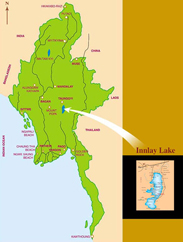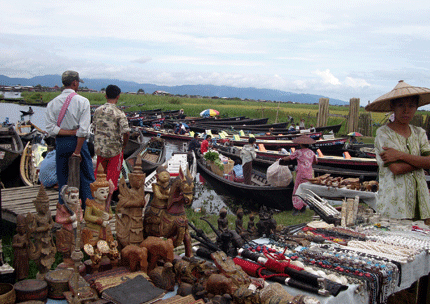Human Flower Project
Monday, September 17, 2007
The Flower-Buddhas of Burma
A tradition of floral sculpture—and a livelihood—are dwindling among the Pa-O in Burma.
 Myanmar/Burma
Myanmar/Burma
with inset of Lake Inle
Map: Shwe Inn Tha
What’s Buddha made of?
We refer not to Siddhartha Gautama or enlightened others but to the figurines long made, traded and devoutly offered in Burma (Myanmar). Kyi Wai’s recent article describes how a floral craft of the Lake Inle region—the molding of dried flowers into statues of Buddha—is vanishing.
“Generations of craftsmen have been making the exquisite statuettes for centuries, molding them from the petals of dried flowers, mixed with powder, teak sawdust and resin. Figurines molded from the petals of flowers and donated to lakeside temples are invested with miraculous powers by the Pa-O, Shan and Intha people who live in the region.” Smaller statues also sell, of course, to travelers as souvenirs of this beautiful place.
“The rising cost of the raw materials, particularly the teak sawdust and resin, and encroaching competition from manufacturers of cheap wooden and plastic Buddhas have brought the local handicraft business practically to a standstill,” Wai writes. According to one source, there are only two or three traditional flower-Buddha makers left. “Twenty years ago, a flourishing demand for the Buddhas kept at least a dozen craftsmen busy.” Some of these statues were larger than life, up to six feet tall.

Flower buddhas for sale at the Nam Pam Market along Lake Inle, Burma
Photo: The Irrawaddy
The problem doesn’t seem to be the cost of flowers (which are plentiful here) but the price of teak sawdust, which over the past two decades has risen from the US equivalent of 8 cents per bag to $2.30.
One wonders, too, whether changing religious observances in the area might also account for the decline. We’ve read that caves and temples surrounding the lake were once laden with Buddha figures. The Pindaya cave is said to contain thousands of statues of all sizes. Are there no longer so many pilgrims to this holy site? Or has their form of worship changed?
We’re grateful to learn of this fascinating craft from Burma, one of too many floral customs that appear to be fading in the face of industrialization, secularization and the high costs of living for many in the world. We hope to hear more from readers who live in Myanmar or are fortunate enough to travel to Inle Lake.




